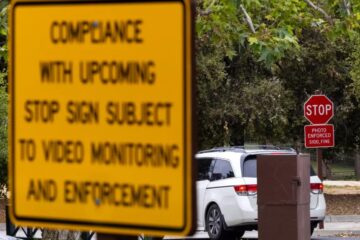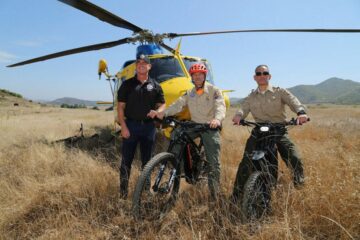Blocking Castro Peak Motorway
Tycoon revels in the battle of Castro Peak. Radio tower owner fights the feds, county, state and neighbors in his bid to build a ranch above Malibu.
Source of this article – Los Angeles Times, February 5, 2004.
James A. Kay Jr., a radio tower tycoon from Las Vegas with houses in four states and Mexico, says all he wants to do is build a weekend home and hobby ranch on Castro Peak in the Santa Monica Mountains.
As modest as he makes it sound, his project has pitted him against Los Angeles County, the National Park Service, the California Coastal Commission and two dozen neighbors, whom he dismisses as “hillbillies.”

Blunt: James A. Kay Jr., the target of a federal investigation over an illegally cleared road across neighboring national parkland, stands by his sign with a message for National Park Service rangers. He has also been cited by the county for violating building codes.
And he’s likely to attract more critics if he carries out his threat to pave a nearly mile-long stretch of the Backbone Trail, which runs through state and federal parkland along the spine of the Santa Monicas. His right of way, he says, is 60 feet wide.
“I intend to pave it like the Ventura Freeway expansion project,” he said.
Kay insists that he didn’t start the fight, though he is clearly enjoying himself. The 47-year-old businessman said his successful career in the dog-eat-dog commercial radio tower industry had taught him that a fierce counterattack was the best strategy to get what he wanted.
“One of my competitors in the radio industry called me ‘an enraged, rabid pit bull chewing his calf to the bone.’ I took that as a compliment. No matter how he tried to beat on me, I kept on chewing.”
Kay’s neighbors say he is a bully.
“It’s just plain meanness,” said Linda Palmer, a longtime leader of the Santa Monica Mountains Trails Council. “He’s not hurting the Park Service” as he intends, she said. “The Park Service doesn’t have any feelings. He’s hurting people.”
Kay has been cited by the county for violating building codes, drawn a cease-and-desist order from the Coastal Commission for blazing roads without permits and become the target of a federal investigation over an illegally cleared road across neighboring national parkland.

View Lot: James Kay, with Companion Kathy Hock, stands on land where he wants to build a weekend home and hobby ranch.
Kay says he has done nothing wrong in the process of acquiring about 400 acres of mountain land between Westlake Village and Malibu and laying the groundwork for his ranch, though he admits that a work crew mistakenly dug into a hillside and regraded a short stretch of road on his property.
Nancy Goldstein, a lawyer defending 16 of Kay’s neighbors against a lawsuit he filed, said she is familiar with his tactics from previous court fights. “He enjoys the battle,” she said. “He enjoys matching his wits against attorneys. He thinks it’s great sport.”
Indeed, Kay brags that he has been engaged in “the longest, most expensive, most acrimonious fight” in the history of the Federal Communications Commission, which he said tried to strip him of his FCC licenses. He emerged from the decade-long battle richer than ever; he calls himself a “centa-millionaire,” someone worth $100 million.
He owns or leases radio towers at 22 mountaintop locations. The towers relay signals used by ambulances, tow trucks and security firms. He also operates a condo rental business in the Baja California community of Rosarito Beach.
“If the bureaucrats think they will beat me down by running up lawyers’ bills, they are barking up the wrong tree,” Kay said. He figures he has spent $5 million on Santa Monica Mountains land acquisition and $300,000 on related legal fees so far. “It’s all business expenses. It’s not like I’m going to miss it.”
Meanwhile, Kay is taking the fight to the National Park Service on another front, buying up property before the government can acquire it as parkland. Kay purchased most of that acreage from Brian Sweeney, a land speculator who gained notoriety for hiring a professional hunter to try to track down the last male mountain lion in the Santa Monicas.
One parcel Kay has acquired entitles him to a right of way that happens to coincide for almost a mile with the Backbone Trail near its intersection with Kanan Dume Road. Surveyors hired by Kay have put in orange poles, marking the easement he plans to bulldoze and then pave.
“There is one thing I learned from the radio industry. You don’t just keep the fight at the place they attack you. You go find where they are vulnerable and do it back,” he said.
Kay also has erected metal gates, strung barbed wire and posted “No Trespassing” signs to block public access to another popular hiking and equestrian trail that crosses his land on Castro Peak, where he owns a cluster of commercial two-way radio towers.
One “No Trespassing” billboard orders National Park Service rangers to “get the hell off our land and don’t come back!”
Kay has sued 23 of his neighbors who own land along the seldom used, largely unpaved Castro Peak Motorway, which winds its way up to Kay’s property on the mountain. He said he sued them after they failed to sign over formal access to the motorway, a little-used dirt road that crosses their land – an easement long used by radio tower maintenance workers.
He also has sued the Coastal Commission to force it to grant him a retroactive permit for the more than two miles of roads he has cleared on his property. The commission requires permits for grading roads and other privately owned development in the designated coastal zone.
“I didn’t go out of my way to pick a fight with the National Park Service, the Coastal Commission or the county of Los Angeles or the neighbors,” Kay said. “They came after me.”
He says the Park Service wants to get control of his land and is working with the commission to challenge everything he does.
They just didn’t know who they were pushing around, he said. “It’s like when a mugger tries to take someone down and discovers it’s Mike Tyson in a bad mood.”
Both the Park Service and the Coastal Commission deny that they are trying to force Kay out.
“I have evaluated his claim of collusion and see no validity to it,” said Woody Smeck, superintendent of the Santa Monica Mountains National Recreation Area.
Smeck, as well as state and county officials, say they respect Kay’s private property rights, but have insisted that he follow development rules that ensure public safety, protect habitat for wildlife and make sure neighboring development is compatible with park wild-land areas set aside for the public.
Kay inherited some of the problems from the previous owner of a cluster of radio towers and buildings on Castro Peak. Before he took control of the property in 1999, his predecessor had built a 120-foot radio tower on the property line shared with the National Park Service so that two of the tower’s three feet were planted on public parkland. The Park Service has spent years trying to get the tower moved – without success.
The previous owner also installed an 800-square-foot trailer for a caretaker without a permit and built several other facilities, which lacked permits or failed to meet building codes.
Kay says he has spent years trying to rectify these problems but has hit bureaucratic snags. He won’t take down the radio tower, he said, until he gets permission to rebuild it on his property. He cannot get permits for the caretaker’s trailer until he can prove that he has legal access to the property by way of Castro Peak Motorway.
Goldstein, the lawyer who represents 16 of the 23 neighbors named in Kay’s lawsuit, said Kay never tried to work out the access issue with the neighbors, who are concerned about increased traffic on the winding dirt road. She said his workers had already been in one accident with a neighbor – a mishap that is the subject of yet another lawsuit.
Instead, Kay’s lawyers sent each neighbor along the motorway between his land and the paved Latigo Canyon Road to the west a letter threatening a lawsuit within 10 days if they didn’t sign a document giving him access to the dirt road. Only one signed, Goldstein said. Kay sued most of the others within the month.
He increased the tension with government agencies when he hired work crews to clear more than two miles of brush. The Coastal Commission accuses Kay of creating roads on his own land where none had existed. Kay argues that he only cleared chaparral from existing roads.
The Park Service contends that Kay’s crews continued clearing brush for half a mile across national park land to give him a second way onto his property.
Smeck, the park superintendent, said the U.S. attorney’s office is reviewing possible charges involving the brush clearing on public parkland. “We have a strong case,” he said.
Kay denies that he or his crews cleared any brush on national park land. When asked about the federal investigation and the possibility of charges against him, he responded: “Bring it on.” After he beats the charge, he said, “I’ll sue them for malicious prosecution.”
Kay acknowledges that he cleared the other two-plus miles of road on his own property. He said he took pains to avoid scarring the land, requiring work crews to use hand tools, such as shovels and rakes and pickaxes, instead of bulldozers.

Battle in the mountains: James A. Kay Jr., a commercial radio tower owner, wants to build a luxury home and ranch around Castro Peak. Annoyed at neighbors and park officials, he has bought property earmarked as future parkland, erected gates to block a popular trail that crosses his land and treatened to pave a piece of the Backbone Trail.
Such regular maintenance of preexisting roads with hand tools is routinely exempted from permits required by the Coastal Commission, said Don Schmitz, a land planner whom Kay retained. Schmitz told the commission that, unfortunately, Kay’s crews mistakenly cut into hillsides and moved rocks and dirt at a couple of places along the route.
“It’s disappointing to me,” Schmitz later said, “because it calls into question the credibility of the entire property.”
The roadwork done on Kay’s land without a permit prompted the commission in December to order him to halt all road building and restore the area with native chaparral.
“There was an obscene amount of development in this area without anyone bothering to seek a permit,” Commissioner Trent Orr said at the time.
Kay has since won a court order that suspends the commission’s order to restore the area until the commission considers an after-the-fact permit for these roads. The matter will be taken up at the coastal panel’s meeting this month.
Standing on Castro Peak, Kay indicated where he wanted to build a home, with a spectacular 360-degree view that takes in the Channel Islands, Mt. Baldy and the Simi Hills.
“I could retire, travel the world and get bored,” Kay said. “Everyone who did this in my industry has died.”
Sparring with the government bureaucrats, he said, invigorates him. “This is my entertainment.”


